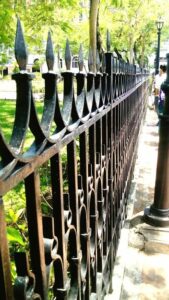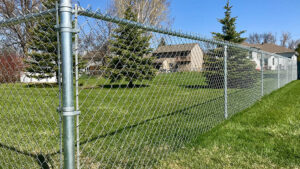 Metal Fencing
Metal Fencing
Metal fences are a great way to protect your yard from passersby and intruders and keep pets enclosed. But how did the first metal fences originate? Historically, metal fencing has evolved from simple iron barriers to intricate ornamental designs, showcasing functionality and beauty.
The First Metal Fences
Only the richest people in Colonial America could afford the wrought ironwork desired for their stone and brick homes. However, once the 1800s started, blacksmithing grew within the country, and ornamental ironwork adorned many housing styles of the period. It became extremely popular during Victorian times as foundries mass-produced different posts and pickets.
Metal Fencing Today
Nowadays, metal fencing is usually suggested to be made of iron rather than iron itself. It is usually made from weather-proof aluminum or readily available steel. The pickets are usually hollow and resemble the solidness of iron bars. The result is more lightweight fencing that is easy to fasten together.
Traditional wrought iron fences can replace the top coat of paint with a longer-lasting powder coating applied in multiple steps. It is possible to restore traditional wrought iron by melting down any salvaged material. It can then be reworked traditionally. Restoration projects or traditional wrought iron fences are often too expensive for most people today.
Metal fencing is sometimes branded as iron fencing when it is solid steel or solid aluminum. It often has added scrolls made from machines and details cast like rosette shapes. This can save on cost. Custom fabricators can mix different manufacturing methods and materials to join cast-iron parts and details with pickets made from hollow steel. Making cast-iron fence panels from molds to feature Victorian-era shapes is also possible. These are more expensive than other types of metal fencing, though.
Solid steel is simple yet durable. Hollow posts with cast ball finials welded to the rails along the top and bottom of the fence are available. Prefabricated fence panels like this are also available, with prices usually around the $15 mark. Aluminum is normally slightly cheaper, with cast iron being much more expensive!
Can you DIY with a metal fence?
If you have DIY experience, putting in a metal fence should not be a problem. You’ll have to dig some post holes and add them to the concrete. However, it’s better to get an expert if your steel is heavy or if you’re using cast iron.
Compared with wooden fences, metal ones have a lot less maintenance. They can be recoated if they become scratched to prevent rust. If your chosen fence is made from rust-proof aluminum, then there’s pretty much no maintenance required at all.
They can also last over twenty years if you protect their finish, perhaps even longer if you have a hollow steel fence. Tubular aluminum, cast iron, and solid steel can last a lifetime.
Planning to secure your yard?
AAA Fence is your premier choice for metal fencing. With a reputation for high-quality ornamental aluminum fences, we offer unmatched security and aesthetic appeal for residential communities, apartment complexes, industrial plants, and more.
Contact us today for more details and information.

